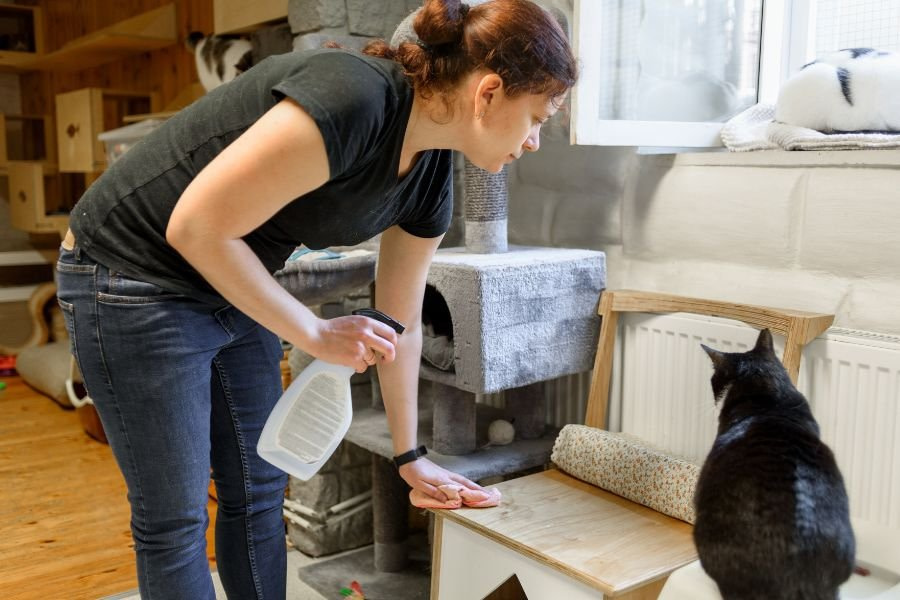Cleaning cat pee can be a challenging task, especially if you don’t know where to start. First, you’ll need to identify the source, which might involve a visual inspection or using a black light. Once you locate the spot, it’s important to blot the area immediately with an old towel, but avoid rubbing to prevent the urine from seeping deeper into the fabric. After that, you should choose the right cleaning solution, like an enzymatic cleaner or a vinegar solution. But what do you do if the smell persists or it’s an old stain? Let’s explore the next steps.

Key Takeaways
- Use an enzymatic cleaner to effectively break down urine and neutralise odours.
- Blot the urine immediately with old towels to absorb as much as possible.
- Sprinkle baking soda over the affected area to neutralise odours, then vacuum thoroughly.
- Apply a vinegar solution or hydrogen peroxide for natural cleaning and odour removal.
- Thoroughly clean non-carpeted surfaces with pet-safe detergent and water, ensuring proper ventilation to expedite drying.
Identify the Source
To effectively clean cat pee, first, identify the source by looking for wet spots, stains, or strong ammonia odours in your home. Begin by systematically inspecting areas where your cat frequently spends time. Carpets, furniture, and bedding are common sites. You must locate affected areas and check for stains. The presence of a strong ammonia odour is a clear indicator of cat urine.
To guarantee thorough identification, use a black light to find hidden spots that aren’t visible to the naked eye. Cat urine contains compounds that will fluoresce under black light, making it easier to detect. Turn off the room lights and slowly scan the suspected areas with the black light. Any hidden urine stains will reveal themselves as glowing spots.
Understanding the source of the odour is vital for effective cleaning. Once you identify the affected areas, you can take appropriate steps to eliminate the stains and odours. Don’t neglect to recheck the areas, as residual urine can contribute to persistent smells and future accidents.
Identifying the source accurately ensures that you can proceed with the cleaning process effectively, ensuring a fresher, cleaner home environment.
Blot the Urine
Begin by using an old towel to blot and absorb the cat urine immediately, aiming to prevent it from seeping into the surface. Employing a proper blotting technique is important for effective clean-up.
Gently press down on the affected area with absorbent towels, ensuring you cover the entire spot. This quick action is vital to prevent spreading the urine further into the material.
Avoid rubbing or scrubbing the area, as this can inadvertently force the urine deeper into the fibres, making it harder to remove. Continue the blotting process until the towel no longer picks up any moisture, indicating that most of the urine has been absorbed.
Using multiple layers of towels can enhance the absorbency and efficiency of this method. The key here is to act swiftly and thoroughly, as delayed response can lead to more complex cleaning challenges.
Apply a Cleaning Solution
Choose an enzymatic cleaner specifically designed to break down and neutralise cat urine odours effectively. These enzymatic cleaners contain bio-enzymes that target and decompose the uric acid crystals in cat urine, which are notoriously difficult to eliminate. Follow the instructions on the product label, applying it generously to the affected area to guarantee thorough coverage.

For areas where you prefer a more natural approach, a vinegar solution can be effective. Mix one part white vinegar with one part water and apply it to the soiled area. Vinegar’s acidity will neutralise the alkaline salts in cat urine, reducing odour. However, enzymatic cleaners are generally more effective for stubborn stains.
Hydrogen peroxide is another option for disinfecting and deodorizing. Use a 3% hydrogen peroxide solution and apply it directly to the spot, letting it sit for a few minutes before blotting. Pet odour removers, specifically those without ammonia, can also be used as they’re formulated to target urine odours.
For an invigorating scent, you might opt for a lemon juice spray. Mix lemon juice with water in a spray bottle and apply to the area after cleaning. This can serve as a natural deterrent for future incidents.
Treat With Baking Soda
Sprinkle a generous amount of baking soda over the affected area to begin neutralising the cat pee odour. Baking soda benefits include its status as a highly effective natural odour eliminator, making it a great choice for this task. Its odour absorbing properties work by neutralising the acidic components of cat urine, providing a reliable cat pee solution.
Allow the baking soda to sit for several hours or, for best results, overnight. This duration maximizes its effectiveness as an odour neutraliser. The extended exposure ensures deep penetration into the fibres of the carpet or other materials, thereby enhancing its odour-absorbing capabilities.
After the baking soda has had sufficient time to work, vacuum the area thoroughly. This step completes the process by removing both the baking soda and the neutralised odour particles trapped within it. Using this effective cleaning method guarantees a significant reduction, if not complete elimination, of the lingering cat pee smell.
If the odour persists, repeat the process. Stubborn or lingering odours may require multiple treatments, but the benefits of using baking soda as a natural and effective cleaning solution make it an invaluable tool in maintaining a fresh and odour-free environment.
Clean Non-Carpeted Surfaces
When addressing cat pee on non-carpeted surfaces, it’s essential to use ammonia-free and vinegar-free cleaning solutions to prevent re-attracting your cat to the area. Start with surface preparation by wiping away any excess urine with paper towels. This initial step facilitates effective stain removal and prevents urine from seeping deeper into the surface.
Next, apply an enzymatic cleaner designed for pet stains. These cleaners are particularly effective for odour elimination and breaking down the uric acid in cat urine, which is the primary culprit behind persistent smells. Ensure thorough coverage by spraying the cleaner generously over the affected area.
Allow the cleaner to sit for the recommended time on the product label, typically 10-15 minutes. This soaking period is vital for thorough stain removal and odour elimination. Afterward, wipe down the surface with a clean cloth or paper towel, making sure all residues are removed.
For preventive measures, clean the area again with a mild, pet-safe detergent and water to remove any lingering traces. Proper ventilation is essential during this process to help dissipate odours and expedite drying. Repeat these cleaning techniques if necessary to guarantee the area is fully sanitized and odour-free.
Use Odour Neutralisers
Utilising odour neutralisers like enzymatic cleaners is vital for breaking down uric acid in cat urine, guaranteeing the smell is eliminated at its source. When choosing the right brand, opt for those specifically formulated for pet stains, as these have been clinically tested for effectiveness. Understanding enzyme action is essential; enzymes break down the uric acid crystals in cat urine, converting them into gases that evaporate, unlike standard cleaners that merely mask odours.
Comparing effectiveness levels among various brands can be insightful. Look for products with high user ratings and scientific backing, such as Nature’s Miracle or Rocco & Roxie. These brands have demonstrated superior results in neutralising cat urine odour.
Application tips include saturating the affected area thoroughly and allowing the enzymatic cleaner to sit for the time specified on the product label, typically 10-15 minutes. This ensures the enzymes have ample time to break down the uric acid.
The benefits of using neutralisers extend beyond odour elimination. They prevent re-marking by removing the scent markers that attract cats back to the same spot. Additionally, these products are safe for use on carpets, furniture, and other fabrics, preserving the integrity of your household items.
Deep Clean Soft Furnishings
Saturation of the affected area on your soft furnishings with a mixture of water and enzymatic cleaner is essential to guarantee thorough penetration. This ensures that the cleaning solution reaches deep into the fabric fibres for effective stain removal and odour elimination. Blot the area with a clean cloth to absorb both the cleaner and residual urine, applying gentle pressure to avoid spreading the stain.
For top-notch upholstery care, follow up with a steam clean. This method not only aids in further stain removal but also contributes to fabric restoration by lifting dirt and neutralising odours. Make sure to use a steam cleaner appropriate for your specific type of fabric to prevent damage.
Allow the treated area to air dry naturally. This step is vital as it ensures that the enzymatic cleaner has sufficient time to break down the urine compounds completely.
To enhance odour elimination, sprinkle a light layer of baking soda over the area once dry and let it sit for several hours before vacuuming.
Repeat Cleaning Process
It’s essential to repeat the cleaning process multiple times to guarantee complete removal of cat pee odour and stains. Effective odour prevention hinges on thorough stain removal, especially on carpets where urine can seep deep into fibres. Begin by making sure that your initial cleaning steps are thorough and that the affected area is completely dry. This prevents moisture from trapping odours and allows for more accurate assessment of whether additional rounds of cleaning are necessary.
In terms of carpet care, consistent application of pet-safe enzymatic cleaners is critical. These cleaners break down uric acid crystals, aiding in scent elimination. After applying the cleaner, let it sit to penetrate the fibres, then blot it up again. Be prepared to repeat this process multiple times, as cat urine can be persistent.
For non-carpeted surfaces, surface disinfection is key. Use an ammonia and vinegar-free cleaner to avoid attracting the cat back to the same spot. Disinfecting ensures that all bacteria are eradicated, contributing to complete odour removal.
Address Old Accidents
To effectively address old cat pee accidents, begin by applying an enzyme cleaner that specifically targets and breaks down uric acid crystals. Enzyme cleaners are essential for thorough odour elimination and stain removal, as they chemically dismantle the uric acid compounds that traditional cleaners can’t.
Allow the enzyme cleaner to sit on the affected area for several hours to guarantee maximum efficacy. For carpet protection, it’s vital to thoroughly saturate the area, as cat urine can penetrate deep into carpet fibres and padding. Cover the treated spot with a laundry basket or another barrier to prevent your cat from re-marking the area while the cleaner works.
After the enzyme cleaner has dried, inspect the area for any remaining discoloration or odour. If necessary, repeat the process for complete stain removal. Ensuring proper ventilation by opening windows and using fans will expedite drying and help dissipate residual odours.
For long term solutions, understanding the underlying causes of your cat’s accidents can be beneficial. If persistent issues arise, seeking professional help from a veterinarian or animal behaviourist may provide insights and strategies to prevent future incidents.
Addressing old accidents thoroughly is key to maintaining a clean, odour-free environment.
Prevent Future Accidents
Ensuring a clean, odour-free home requires addressing the root causes of your cat’s accidents and implementing preventive strategies. First, establish a consistent routine for feeding, playtime, and litter box use. Cats thrive on predictability, and a stable environment reduces their stress, which can lead to fewer accidents.
Create boundaries within your home to designate appropriate areas for your cat’s activities. Make sure the litter box is in a quiet, accessible location, and consider using multiple boxes if you have more than one cat. Reward good behaviour by offering treats and positive reinforcement when your cat uses the litter box correctly. This encourages them to repeat the desired behaviour.
Monitoring your cat’s behaviour is essential. Pay attention to any changes in their habits or elimination patterns, as these can be early signs of underlying health issues or environmental stressors.
If accidents persist despite your efforts, seek professional help from a veterinarian or an animal behaviourist to rule out medical conditions or provide targeted behavioural interventions.
Frequently Asked Questions (FAQ)
How to remove cat pee smell from carpet?
To remove cat pee smell from carpet, first blot up as much of the urine as possible. Then, mix a solution of vinegar and water and apply it to the affected area. Let it sit for a few minutes before blotting it up again. Repeat if necessary.
What is the best way to clean a litter box?
The best way to clean a litter box is to empty out all the old litter, wash the box with soap and water, and dry it thoroughly before adding fresh litter. It is recommended to clean the litter box at least once a week to prevent odours.
How to prevent cats from peeing outside the litter box?
To prevent your cat from peeing outside the litter box, ensure that the litter box is clean and in a quiet, accessible location. You can also try using hydrogen peroxide to clean any accident spots and deter your cat from revisiting the same area.
What are the steps to clean cat urine from a floor?
The steps to clean cat urine from a floor include blotting up as much of the urine as possible, applying a mixture of vinegar and water to the area, letting it sit, and then blotting it up again. Repeat as needed until the smell is gone.
How to get rid of the smell of cat pee from my house?
Blot urine, apply enzymatic cleaner to carpets, and use baking soda for odour. Protect furniture with covers, and train cats with positive reinforcement to prevent accidents. Repeat cleaning for stubborn stains, ensuring thorough removal to maintain hygiene.
What is the best way to remove the smell of cat spray?
The best way to remove the smell of cat spray is to clean the affected area with a mixture of vinegar and water. Additionally, neutering male cats can help reduce or eliminate spraying behaviour.
How can I get rid of cat urine smell from my carpet?
To get rid of cat urine smell from your carpet, start by blotting up as much of the urine as possible using paper towels. Then, mix a solution of vinegar and water and pour it over the affected area. Let it sit for a few minutes before blotting it up. You can also use an enzymatic cleaner specifically designed to break down the urine and neutralise the odour.
What is the best way to clean cat urine stains?
The best way to clean cat urine stains is to use an enzyme cleaner that can effectively neutralise the odour and break down the urine molecules. Make sure to scrub the affected area thoroughly and follow up with a solution of white vinegar to eliminate any lingering smells.
Can bleach effectively remove cat urine smell?
Bleach is not recommended for removing cat urine smell as it can actually intensify the odour and may encourage your cat to continue urinating in the same spot. It is best to use enzymatic cleaners or vinegar-based solutions for this purpose.
What kills the smell of cat urine?
Imagine the odour of cat urine as a ghost haunting your home. You’ll need enzyme cleaners, odour neutralisers, hydrogen peroxide, essential oils, and activated charcoal to banish it. Each targets and breaks down the smell at a molecular level.
Can cat pee smell be washed out?
Yes, you can wash out cat pee smell effectively. Use enzyme cleaners to break down urine odour and pee stains. Follow these cleaning tips for smell elimination: blot, apply cleaner, let sit, and guarantee thorough drying.
Does baking soda and vinegar remove cat urine?
When push comes to shove, baking soda and vinegar help, but enzyme cleaners are your best bet. They break down urine enzymes, tackling carpet stains, hardwood floors, and fabric odour more effectively than household remedies.
Conclusion
You have acquired the necessary knowledge and skills to reclaim your living space by contrasting a pristine and sanitary home with the persistent scent of cat urine.
Identifying the source and using enzymatic cleaners or a vinegar solution guarantees effective odour neutralisation.
Blotting, treating with baking soda, and deep cleaning soft furnishings are crucial.
Remember, addressing old stains and preventing future accidents secures a harmonious living environment.
Your diligent efforts will transform a once problematic area into a pristine sanctuary.

